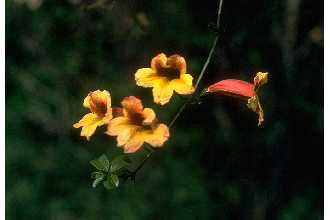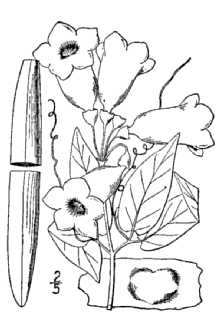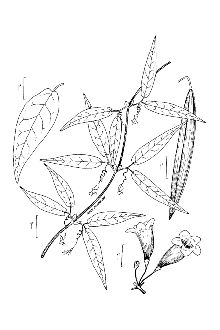Anisostichus crucigera (L.) Bureau
Scientific Name: Anisostichus crucigera (L.) Bureau

| General Information | |
|---|---|
| Usda Symbol | ANCR7 |
| Group | Dicot |
| Life Cycle | Perennial |
| Growth Habits | Vine |
| Native Locations | ANCR7 |
Plant Guide
Alternate Names
Anisostichus capreolata, Anisostichus crucigera, Bignonia capreolata forma lutea, Bignonia capreolata var. atrosanguinea, Doxantha capreolata, quartervine, trumpet flower.
Uses
Ethnobotanic: Native Americans used crossvine as a remedy for numerous health ailments. An infusion of leaves was used to purify blood. Decoctions of leaves were used for rheumatism. Decoctions of mashed bark were used to alleviate edema and headaches. Individuals with diphtheria gargled a mashed root infusion. Ornamental: The showy, fragrant flowers and unique leaves of crossvine make this plant appropriate for some gardening and landscaping needs. It is often used as a cover for fences, arbors, walls, pillars or large trellises and as a groundcover. It is often recommended as a native ornamental alternative to non-native climbing vines. Wildlife: The tubular flowers and large quantities of nectar produced by crossvine are attractants for hummingbirds and butterflies.
Legal Status
Status , Use soil moisture sensors to measure the soil moisture of Anisostichus crucigera (L.) Bureau.
Status
Please consult the PLANTS Web site and your State Department of Natural Resources for this plant’s current status (e.g. threatened or endangered species, state noxious status, and wetland indicator values).
Weediness
Crossvine can spread aggressively. This plant may become weedy or invasive in some regions or habitats and may displace desirable vegetation if not properly managed. Please consult with your local NRCS Field Office, Cooperative Extension Service office, or state natural resource or agriculture department regarding its status and use. J.R. Manhart. 2004. Texas A&M University Herbarium.
Description
General: Bignonia family (Bignoniaceae). Crossvine is a perennial, woody, semi-evergreen vine that can grow to be 17 m long. Tubers can grow to 10 cm in diameter. The stem is squarish and reddish-purple. Leaves are opposite, pinnately compound, and reduced to two basal leaflets and a branched tendril between them. Leaflets are 6-15 cm long, 2-7 cm wide and have smooth edges (entire), narrowly tapered tips (acuminate), and a notch at the base that makes them heart-shaped (cordate). The foliage turns from a lustrous green in the growing season to a reddish purple in the winter. Buds are reddish-purple and less than 1 cm long. Flowers are bell-shaped with orange on the outside and yellow inside, have 5 irregular lobes, and are 4-5 cm long. The fruit is a multi-seeded, flat capsule that is up to 15 cm long. Crossvine blooms from mid-March to mid-June and sets fruit in late summer. Crossvine gets its name from the cross-shaped pith, as seen from a transverse section of the stem. Other key characteristics of crossvine include its opposite compound leaves with two leaflets and branched tendrils. Distribution: Crossvine is native to the United States in the northeastern, north central, south central, and southeastern regions. It is found from southern Ontario, south to Florida, west to Texas and Illinois. For current distribution, please consult the Plant Profile page for this species on the PLANTS Web site (http://plants.usda.gov). Habitat: Crossvine is found in rich forests and swamps and along roadsides and fencerows.
Adaptation
The USDA hardiness zones for crossvine are 5-9. Although it is semi-evergreen, it may lose its leaves during especially harsh winters in zones 5 and 6. Crossvine prefers full sun and moist, acidic, well-drained soils for best flowering. It is adaptable to other soil conditions, including poorly drained soils, once established and it can do well in low light levels. It is drought tolerant.
Management
If not properly managed, crossvine can spread quickly by root suckers and become problematic. Pruning will reduce aggressive growth if spread is not desired.
Seeds and Plant Production
Plant Production
Plant Production
Crossvine can be propagated by seeds or cuttings. Pretreatment of seeds is not necessary. Although a 90% germination rate can be expected, seedling survival and growth may be low. Seedlings may need to harden in winter temperatures before outplanting. The species can be rooted at any time of the year but June or July cuttings are generally recommended. Crossvine cuttings root easily, but may take six to eight weeks. Cultivars, Improved, and Selected Materials (and area of origin) The NRCS Plant Materials Program has not released any cultivars of crossvine for conservation use. Contact your local Natural Resources
Conservation
Service (formerly Soil Conservation Service) office for more information. Look in the phone book under ”United States Government”. The Natural Resources Conservation Service will be listed under the subheading “Department of Agriculture.” Ornamental cultivars of Bignonia capreolata include ‘Atrosanguinea,’ ‘Dragon Lady,’ ‘Helen Fredel,’ ‘Jekyll,’ ‘Shalimar Red,’ and ‘Tangerine Beauty.’ These cultivars have been bred for flower color, flower and leaf size, and winter hardiness.


